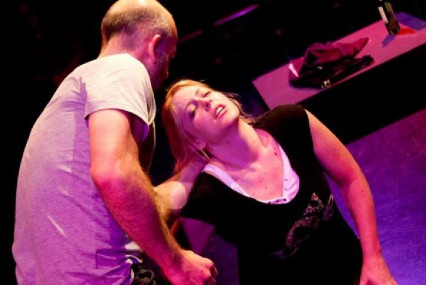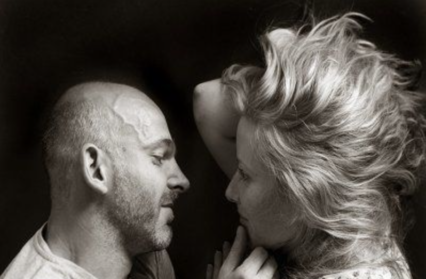Joao Morais attends Chapter Arts Centre to cast a critical eye over the Company of Siren’s latest performance, Stitching.

When Anthony Neilson’s Stitching was performed at the Edinburgh Festival ten years ago, The Guardian reported that the controversial play prompted walkouts from members of the audience. If the Company of Sirens’ latest production is anything to go by, I can safely state that the Edinburgh audience members that chose to leave missed out on an unsettling yet ultimately rewarding depiction of grief and lust.
It is not hard to see why people may have decided to leave. The powerful narrative has the ability to shock and disturb. With a typically gruesome and testing climactic scene that gives the play its title, Neilson’s script could be in danger of alienating some with its bold brutality. The two protagonists, Abby and Stu, find themselves involved in a surreal re-enactment of a previously imagined sexual fantasy. But we are not invited in as voyeurs to this act; we recognise that at this point the characters have lost everything. The final act of mutilation brings nothing but sympathy for them – though I don’t think I will ever be able to listen to The Mending Song from Bagpuss ever again.
But the most shocking thing about the play is not its depictions of sexual debauchery. After all, if beauty is in the eye of the beholder, then obscenity must also be given the same treatment. The sex scenes themselves are actually well choreographed. Starting in anger and violence and ending in passion and confusion, they are performed with immediacy and an uncomfortable realness – the action remains graphic even though the actors remain fully-clothed throughout. Even when Stu is being mothered at Abby’s breast with a sex toy, everything is believable.
And this is what is most shocking about this production. It is how human the characters actually are. For all their faults as people – their infidelities, their destructive relationship that neither can break, the double-bluffing list-making on the pros and cons of abortion – the main sympathy with the characters lies with the fact that their loss that the play unstitches in each confrontational scene is so huge that it warrants a sympathetic interpretation. Abby, played by Stacey Daly, has a need for humiliation and brutality which shows her inherent weaknesses. Stu, played by Nathan Sussex, finds a need for humiliating and degrading Stacy through his sexual fantasies until one of them takes things a step too far.
The narrative itself unfolds in two streams. The first one plays off on a linear line. When Abby finds out that she’s pregnant, she and Stu discuss where to take their relationship and try to sort out their problems. But as their gradually intensifying story is played out, we are given flashbacks of what we are invited to behold as the subverted courting of the couple. Abby is a mature student and prostitute, and Stu is a punter. The closer we get to the climax and epilogue of the whole thing, the closer we get to the truth about their relationship and what brought them to this particular tragic point.
Considering this is a Scottish play, it has travelled extremely well. The only disjointed bit of dialogue that didn’t translate well into the South Walian accents of Nathan Sussex and Stacey Daly was the use of the Scotticism ‘just now,’ which had the effect of momentarily halting the suspension of disbelief brought on by the tense acting. But the delivery itself brought a naturalness to the performances, as well as the intimacy between the two principal actors.
This is no doubt helped by the set design itself. With the audience sat around a central stage, there is no fourth wall for the actors to breakthrough. Played out underneath a chandelier of hanging pictures, letters and child’s drawings, the central space changes colour with the mood of the proceedings. Jo Hughes’ minimal set has two platforms diagonally facing each other over what we believe when entering to be a neutral middle space. But this space acts as an engaging metaphor for the characters’ divide. And as soon as the dialogue intensifies when they meet underneath the pictures, we realise that the divide acts more like a battleground rather than a common ground.
For more performances by Company of Sirens click here.
For more performances at the Chapter Arts Centre click here.
Joao Morais has written multiple contributions for Wales Arts Review.












